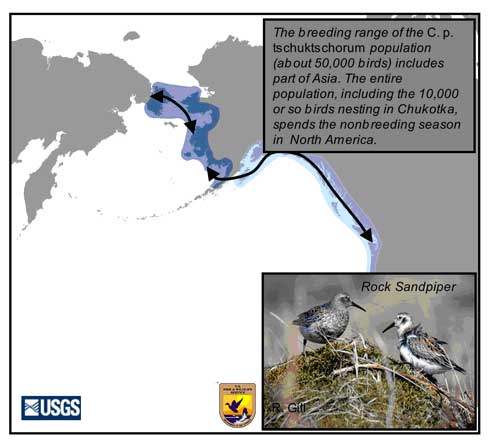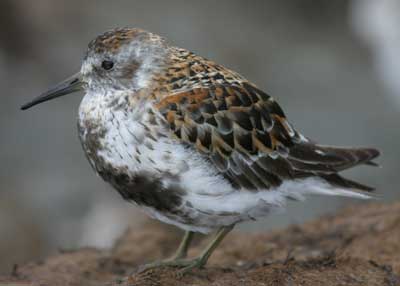Rock Sandpiper, Calidris ptilocnemis tschuktschorum
High-Priority Species ListThis high priority subspecies provides a major migratory link between Asia and North America; about 10,000 birds nest in western Siberia and migrate directly to Alaska in fall.
The tschuktschorum subspecies of the Rock Sandpiper (Calidris ptilocnemis) breeds in coastal mountains and uplands in eastern Russian (Chukotka Peninsula) and western Alaska (from n. Seward Peninsula south throughout Alaska Peninsula) (Gill et al. 2002). The current population is estimated at 50,000 birds with about 10,000 of them nesting in Russia. During post-breeding (Jul-Oct), the entire population migrates to coastal staging areas in western Alaska (Yukon Delta and Bristol Bay) where they molt associate closely with a variety of other shorebirds, including two other subspecies of Rock Sandpiper. The population then spends the remainder of the annual cycle (November-April) at coastal sites in the Pacific Northwest from southeast Alaska to northern California.
No. of samples: Total of 400 cloacal swabs; 300 from adults and 100 from juveniles.
Sampling locations: Primary locations will be coastal lagoons, bays, and exposed shorelines on the Yukon-Kuskokwim Delta (e.g., Angyoyaravak Bay, Hazen Bay, Kuskokwim Shoals). Secondary locations will be northern Bristol Bay (e.g., Chagvan and Egegik bays), Safety Sound on the Seward Peninsula, and more southerly lagoons and bays on the Alaska Peninsula (e.g., Izembek Lagoon, Cold Bay).
Sampling timeframe: Sampling will occur throughout the post-breeding season (late Jul-early Oct).
Sampling demographics: Adults and juveniles of both sexes.
Methods of capture: Birds will be live captured, swabbed, and released. Capture methods that have proven effective for this species include: 1) rocket nets, mist nets, and noose mats set near roost sites and 2) walk-in and bow traps set near feeding and roosting sites. In excess of 2,000 Rock Sandpipers have been trapped and marked by USGS-ASC Shorebird Project personnel since 1978, including hundreds annually during targeted efforts and lesser numbers when capturing other species (i.e., Dunlin C. alpina and Western Sandpipers C. mauri). For example, 170 Rock Sandpipers were captured on the YKD in autumn 2004 and 2005 during efforts to trap Dunlin and Sharp-tailed Sandpipers (C. acuminata). Because Rock Sandpipers form large communal roosts during high tide it is relatively easy also to collect fecal samples from individuals.
Other targeted species: Other priority species available for capture during fall at Rock Sandpiper sampling locations on the central YKD and northern Bristol Bay include: juvenile Sharp-tailed Sandpipers, adult and juvenile Dunlin (C. alpina articola), juvenile Long-billed Dowitchers, and adult and juvenile Bar-tailed Godwits. In addition, several populations of shorebirds that are not currently ranked as high priority for virus sampling are known to associate closely with tschuktschorum in fall and are often captured incidentally during Rock Sandpiper captures [e.g., Black Turnstone, Dunlin (C. a. pacifica)]. It would be possible to collect and archive samples from these populations in the event that further investigation into Asian H5N1 distribution in wild bird populations becomes warranted.
Sampling locations: Primary locations will be coastal lagoons, bays, and exposed shorelines on the Yukon-Kuskokwim Delta (e.g., Angyoyaravak Bay, Hazen Bay, Kuskokwim Shoals). Secondary locations will be northern Bristol Bay (e.g., Chagvan and Egegik bays), Safety Sound on the Seward Peninsula, and more southerly lagoons and bays on the Alaska Peninsula (e.g., Izembek Lagoon, Cold Bay).
Sampling timeframe: Sampling will occur throughout the post-breeding season (late Jul-early Oct).
Sampling demographics: Adults and juveniles of both sexes.
Methods of capture: Birds will be live captured, swabbed, and released. Capture methods that have proven effective for this species include: 1) rocket nets, mist nets, and noose mats set near roost sites and 2) walk-in and bow traps set near feeding and roosting sites. In excess of 2,000 Rock Sandpipers have been trapped and marked by USGS-ASC Shorebird Project personnel since 1978, including hundreds annually during targeted efforts and lesser numbers when capturing other species (i.e., Dunlin C. alpina and Western Sandpipers C. mauri). For example, 170 Rock Sandpipers were captured on the YKD in autumn 2004 and 2005 during efforts to trap Dunlin and Sharp-tailed Sandpipers (C. acuminata). Because Rock Sandpipers form large communal roosts during high tide it is relatively easy also to collect fecal samples from individuals.
Other targeted species: Other priority species available for capture during fall at Rock Sandpiper sampling locations on the central YKD and northern Bristol Bay include: juvenile Sharp-tailed Sandpipers, adult and juvenile Dunlin (C. alpina articola), juvenile Long-billed Dowitchers, and adult and juvenile Bar-tailed Godwits. In addition, several populations of shorebirds that are not currently ranked as high priority for virus sampling are known to associate closely with tschuktschorum in fall and are often captured incidentally during Rock Sandpiper captures [e.g., Black Turnstone, Dunlin (C. a. pacifica)]. It would be possible to collect and archive samples from these populations in the event that further investigation into Asian H5N1 distribution in wild bird populations becomes warranted.
U.S. Fish and Wildlife Service
Yukon Delta NWR
Alaska Peninsula-Becharof NWR
Togiak NWR
Alaska Maritime NWR
Izembek NWR
U.S. Gelogical Survey
Migratory Bird Management
Contact: Richard Lanctot
Contact: Richard Lanctot
Yukon Delta NWR
Contact: Brian McCaffery
Alaska Peninsula-Becharof NWR
Contact: Susan Savage
Togiak NWR
Contact: Rob MacDonald
Alaska Maritime NWR
Contact: Jeff Williams
Izembek NWR
Contact: Kristine Sowl
U.S. Gelogical Survey
Alaska Science Center - Shorebird Project
Contact: Robert Gill
Contact: Robert Gill
Gill, R. E., P. S. Tomkovich, and B. J. McCaffery. 2002. Rock Sandpiper (Calidris ptilocnemis). In The Birds of North America, No. 686 (A. Poole and F. Gill, eds.). The Birds of North America, Inc., Philadelphia, PA.

Ranking Score: 11.5
Asian H5N1 ranking criteria for Rock Sandpiper, Calidris ptilocnemis tschuktschorum.
Total of partial contact with Asia1 |
Contact with known "hot spot"2 |
Habitat used in Asia3 |
Pop. in Alaska4 |
Can samples be obtained? |
Score |
3.0 |
1.0 |
2.5 |
2.0 |
3.0 |
11.5 |
Approx. 23-30% of population nests in Chukotka |
No known use of AI-infected areas |
Nests upland tundra; postbreeding use estuarine areas |
Total pop. 50,000.
~20,000 nest in Chukotka but all return to Alaska enroute to nonbreeding areas in Pacific Northwest |
Easy to trap on nest and during postbreeding flocking |

